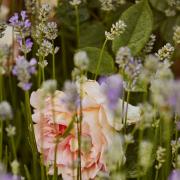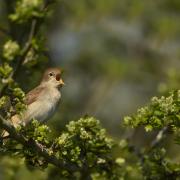It’s a bright spring morning and while the air is cool there is some welcome warmth from the sun. I spot something out of the corner of my eye – my first Adder of the year – whose zig zag markings provide almost perfect camouflage against the backdrop of last year’s Bracken. I move slowly, careful not to cast a shadow and spoil its perfect sunbathing spot and, keeping a respectful distance, take its photograph.
There are six native species of reptile in the UK, and you can find four of them in the Arun Valley. These are the Common Lizard, Slow-worm, Grass Snake and Adder. It is the Adder who is one of our star species at RSPB Pulborough Brooks in springtime. Like all reptiles, Adders are cold blooded – ectothermic if we’re going to get technical – so rely on warmth from outside their body to raise their internal temperature. They spend the winter in hibernation, often snoozing away underground in disused Rabbit burrows where the temperatures are more constant, before emerging in early spring.
It is the males who awaken first, and they find themselves the best sun traps in which to bask and warm up. After this spell of sunbathing, they shed (or slough) their skin and at this point they are looking at their brightest and shiniest best – silver-grey with jet-black zig zags – timed perfectly to coincide with the emergence of the females.
The females have had a bit of a lie-in but when they do wake up they give off a strong scent, which tells the males that they are up and about and it is then that the competition commences. Who would have thought that a cold-blooded snake would dance to impress the ladies? But in the dance of the Adders that is exactly what the males are up to – trying to woo the females and intimidate their rivals. Male Adders rear up and wind around one another, attempting to force their opponent to the ground. Many animals have ways of settling disputes without a potentially fatal fight ensuing – the Adder’s dance is one of the most charming.
Adders have a surprising amount of variation in their colour and each Adder has completely unique markings, especially on the head, which allows us to identify individuals and track them year on year. We use photographs for this purpose – being venomous we certainly don’t attempt to handle them. This is helping us to monitor our population of Adders and discover how many there are, how long they live and how they move around the nature reserve. It’s always fantastic to see some of the familiar ‘faces’ in spring, knowing they have survived the winter floods and frosts.
We manage the habitat to ensure our Adders, and other reptiles, have somewhere to bask, places to shelter and protected commuter routes so they can move safely around the site. As you follow the pathways on our nature trails, tread carefully and quietly whilst scanning the sunny patches and you may just see one of these rare and special creatures. It is always a thrill to see one but please admire them from the path to avoid disturbing them.
To find out more about visiting Pulborough Brooks or our other RSPB nature reserves visit www.rspb.org.uk/days-out/reserves where you can also find information on Reptile Safaris and other wildlife events in Sussex.



























